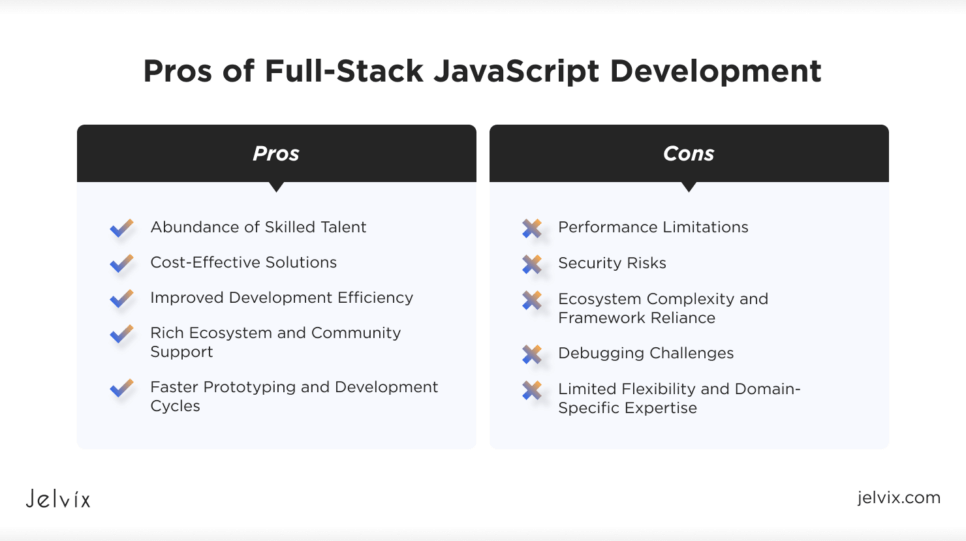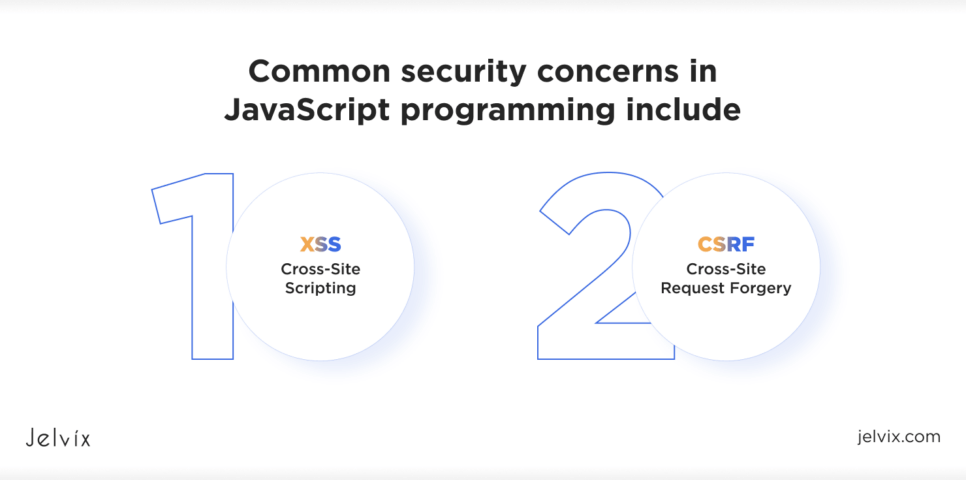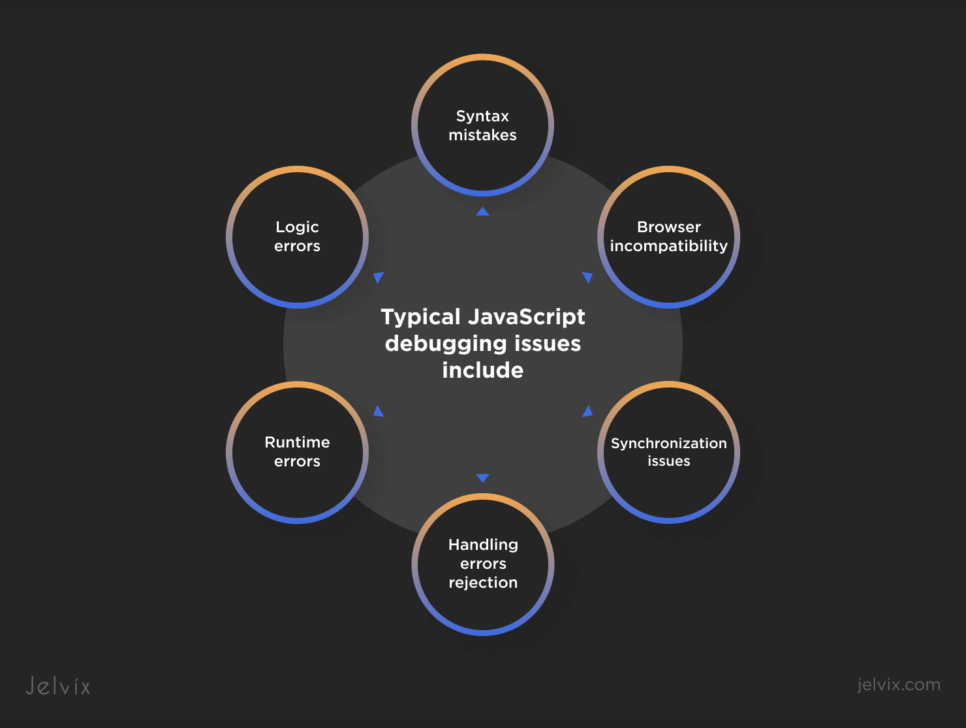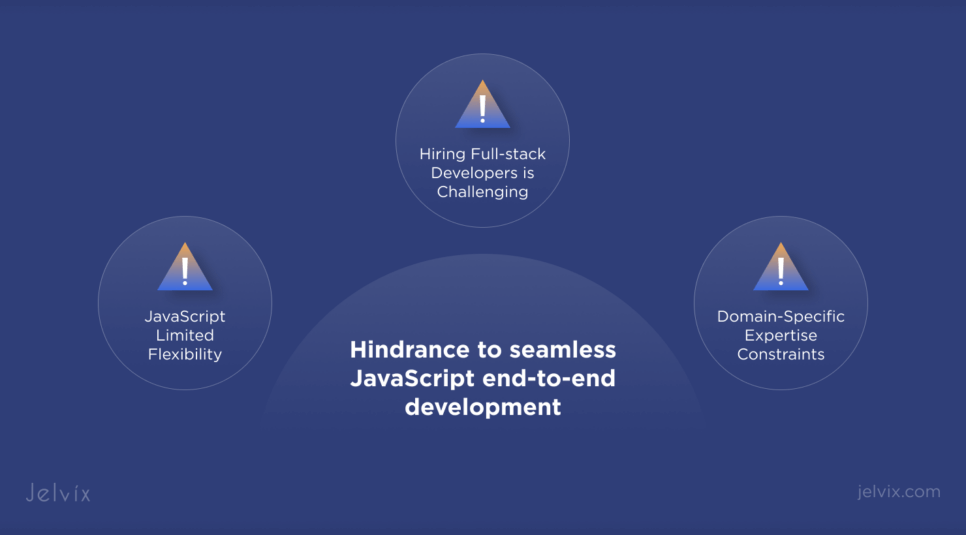JavaScript is a popular programming language for web development. A large number of websites and web apps have been developed using this software development language.
JavaScript, usually associated with frontend development, can now be part of the backend development process. This fact adds extra points to its popularity. Hence, a reasonable question arises whether you can use this programming language for full-stack JavaScript development.
To consider a comprehensive stack JavaScript development team, you must know the advantages and disadvantages of JavaScript full-stack development to make a proper decision.
This article describes the upsides and downsides of full-stack JavaScript development to ease your choice.
So, let’s start with the benefits.
Pros of Full-Stack JavaScript Development
Hiring full-stack developers proficient in Javascript has several benefits for companies that want to create high-quality software. You can learn about them below.
1. Abundance of Skilled Talent
JavaScript has gained exceptional popularity among developers. For example, the Stack Overflow Developer Survey states that 63.61% of programmers mentioned JavaScript as their favorite choice. Numerous JavaScript developers form a vast pool of talents that can help you with full-stack projects. Significant competition can ease finding a skillful end-to-end stack programmer at an affordable rate. High-quality developers have more chances to complete your full-stack development project efficiently and boost your business.
2. Cost-Effective Solutions
At first glance, hiring a top-notch full-stack professional is a costly decision. However, this is not always true. While you employ at least two people, backend and frontend developers, for specialized tasks, the minimal number for full-stack is one person.
Taking aside pricing and focusing on productivity, a comprehensive stack squad can be more efficient. Fewer people on your team can achieve the same results as many specialized developers. You can scale this ability by developing large applications, which can be divided into many smaller projects with microservice architecture. Your team can work on application components simultaneously.
Multi-skilled developers often implement complete features faster than specialized ones. The likelihood of miscommunication within a full-stack team is also lower because programmers are well-versed in client- and server-side development. In the end, comprehensive stack team productivity and application development efficiency enable faster time to market your product.
3. Improved Development Efficiency
The full-stack development team can work with a single programming language. Programmers can create backend and frontend parts of the application using different tools but write the source code consistently. A smaller number of team members speaking a common language ensures fewer blocking tasks and the need for synchronization in the development process. A multifacet developer can easily track his work and comprehend the whole project structure. So, full-stack development also streamlines the debugging and testing process because the end-to-end stack professional knows the entire picture.
In contrast, working with specialized teams means conducting extra meetings to coordinate server and client-side developers’ work. Writing in different programming languages also creates hurdles and redundant code creation. In such cases, a comprehensive stack team performs software development tasks more efficiently than a specialized squad.
4. Rich Ecosystem and Community Support
JavaScript is represented on the web development landscape with an enormous number of tools, libraries, and JavaScript frameworks. Next.js and Nest.js are very popular choices that connect full-stack development. Most MEAN (MongoDB, Express.js, Angular, Node.js), MEEN (MongoDB, Express.js, Ember.js, Node.js), MEVN (MongoDB, Express.js, Vue.js, Node.js), and MERN (MongoDB, Express.js, React.js, Node.js) stack components are open source. That is why most developers get access to popular tools without paying anything. They can also leverage regular improvements, updates, dedicated JavaScript communities, and robust development environments.
Supported by such titans as Google and Facebook, JavaScript has a strong and continuously growing community. In September 2024, around 1.2 million repositories on Github and over 2.5 million questions tagged JavaScript on Stack Overflow. These figures show a significant level of activity within the developer community.
Full-stack JavaScript developers can draw upon a plethora of resources, including extensive documentation, ebooks, dedicated forums, and communities, to create high-quality applications.
5. Faster Prototyping and Development Cycles
The accessibility and versatility of numerous JavaScript frameworks enable rapid prototyping. Full-stack developers can quickly create applications and adjust based on user feedback.
Code reusability increases because of the usage of JavaScript for both frontend and backend JavaScript development. Developers can repurpose code segments with shared logic and implementation across different application components. They reduce the code base size by implementing such a practice. Then, the workload for full-stack developers shrinks, improving the development process efficiency. The source code becomes more manageable, and end-to-end stack programmers can easily maintain and update their products.
Knowing the entire project, full-stack developers tend to build applications and avoid security vulnerabilities. This fact is another bonus of end-to-end stack development.
Cons of Full-Stack JavaScript Development
Despite the abovementioned benefits, end-to-end JavaScript development has several downsides. Read about the hindrances that need the most attention below.
1. Performance Limitations
Using a Node.JS environment to build web applications is a common practice. Unless you create an app that requires extremely intensive data processing on the server side, in this case, application performance may be lagging. The solution for such complex tasks may be the microservices architecture that will break down your project into small pieces. However, this method can sometimes add more complexity to your project, requiring more time and money.
Another concern is the immaturity of JavaScript as a programming language for the backend. Initially, JavaScript was aimed at being a tool for frontend development. Server-side programming possibilities have appeared not so long ago. Backend engineers state that JavaScript has specific constraints on the server side, making it less beneficial for the backend development than programming languages that successfully work with server-side operations, such as Java, C#, Go, or PHP.
2. Security Risks
JavaScript is widespread on the web. Around 95% of websites are built using this programming language. There is practically no other choice other than Javascript for website frontend development. That is why Javascript applications and web pages have become frequent targets for security attacks. Security-related concerns connected with this programming language include cross-site scripting (XSS), cross-site request forgery (CSRF), and other security issues.
XSS allows intruders to add a malicious script to the web page, for instance, on the online banking website presented to a victim. Such a script can enable access to applications with the victim’s privileges and disclose private information or transfer money without the user’s authorization. As a solution, you can use the HTML sanitization.
CSRF implies that the attacker’s code in the site tricks the victim’s browser into taking actions the user didn’t want to do at the target site. Requests originating from code on an attacker’s site can carry the same valid login credentials of the initiating user when target sites rely entirely on cookies for request authentication. It is recommended that any request with lasting effects be authenticated using a hidden form field and not only through cookies. It is also helpful to check the HTTP Referrer header.
What else can developers do to safeguard users from security issues? The correct design of web applications, which eliminates potential threats, may be helpful. DevSecOps practices are also useful for improving app design and preventing malicious attacks. Also, ensure the application has all necessary authentication and authorization features to protect users from fraud. Remember that the top-notch security features within the app improve the app’s credibility in the market.
3. Ecosystem Complexity and Framework Reliance
The flip side of JavaScript’s extensive ecosystem with multiple tools, libraries, and frameworks is its complexity. Keeping tabs on front and backend documentation can be challenging. Developers don’t have enough time to monitor changes and updates in numerous libraries and frameworks. JavaScript relies significantly on frameworks, leading to potential code organization maintenance issues.
4. Debugging Challenges
JavaScript has an asynchronous capability, which means that operations can run separately from the primary program flow during the execution process. This ability enables the main program to continue processing without delays. The asynchronous feature is essential for a smooth user experience but also has debugging difficulties. Typical JavaScript debugging issues include:
- Syntax mistakes: Errors like missing brackets, typos, and incorrect syntax are sometimes hard to identify;
- Logic errors: Incorrect logic in implementation, which is challenging to detect, can cause unexpected behavior;
- Browser incompatibility: Different browsers work with JavaScript differently, leading to challenging compatibility issues;
- Runtime errors: Code execution can cause unexpected program termination when this type of error occurs;
- Synchronization issues: This error happens when numerous asynchronous operations need to be completed or coordinated in a specific order;
- Handling errors rejection: This failure implies mishandling rejected promises or caught exceptions.
Correct and timely working with debugging of the synchronous JavaScript errors is vital for seamless application performance. The most widely used practices for handling such issues are callbacks, async/await, and promises.
5. Limited Flexibility and Domain-Specific Expertise
Limitations considering JavaScript full-stack development can be technical, expertise-related, and software development market ones. Let’s reveal each hindrance to smooth JavaScript end-to-end application development experience.
JavaScript Limited Flexibility
JavaScript syntax is almost the same for backend and frontend development. However, despite JavaScript’s versatility, in some cases, system-level operations may still need specialized languages or technologies like C# or Java. Such long-time running technologies can be beneficial, containing some valuable but old code pieces.
Of course, it is easy to integrate components in the same environment. However, you are not required to do it directly from a new backend. That is true, especially when you can use cost-efficient or convenient solutions like creating lightweight proxies and communicating with them from a new code.
Using JavaScript’s comprehensive stack can sometimes lead to inefficient technical solutions.
Read more about the most common software development strategies and take a look at their benefits and drawbacks.
Domain-Specific Expertise Constraints
Everyone starts their career being prone to either server-side or client-side development. A backend developer should know Node.JS, various databases, backend packages, message queues, and maybe AWS or GCP. Frontend developer gains experience with CSS, HTML, frontend packages, and a few UI frameworks.
A full-stack developer has to be experienced in everything above. If you compare specialized talent with an end-to-end stack developer with the same years of experience, you’ll notice how they differ in working with technologies. A specialist who uses only one technology has more opportunities to spend more time and effort to master either client-side or server-side nuances. So, such professionals possess more profound knowledge to write better code for a separate part of the project.
On the other hand, a full-stack developer starts, for instance, from frontend development and then switches to backend development, or vice versa. They don’t have enough time to master each sphere. The constant appearance of new technologies makes it challenging or almost impossible to catch all the new intricacies even in one area. Developers usually stay prone to one specific domain, adding another one to be competitive or open new realms and break new boundaries. However, with each new knowledge and experience, previously acquired experience becomes less significant.
It is also worth mentioning that not everyone wants to be a jack of all trades and learn something new because they must leave their comfort zone. It is not always possible for many people to learn something new and develop themselves. That is why, despite the rising number of full-stack programmers in recent years, specialized programmers still take a large piece of the “software development pie.”
What happens if a professional leaves the company? No one would barely notice this in the large enterprise. However, this situation may be considered a constraint for a small company that deals with full-stack talent. Of course, everyone should be responsible for a specific part of the project. When someone leaves, other developers should review their code to figure out how it performs before implementing new features.
Developers working in full-stack teams implement features from the beginning to the end. Everyone should know different application components. It applies to big applications divided into numerous small projects with specific subteams. Programmers inside such teams should know their team responsibilities.
Losing a teammate is also an issue for specialized teams. However, for small companies, a full-stack development squad is more common. So, this limitation also applies to them.
Hiring Full-stack Developers is Challenging
The demand for end-to-end stack development expertise stays high and constantly increases. More companies are eager to see full-stack developers in their teams. The need for multifaceted specialists is high for startups and small companies because they consider specialized squads too expensive. This choice is dictated by the fact that they can’t hire too many people at the starting point. So, everyone should be a well-rounded professional.
The rising demand for end-to-end stack developers makes hiring them much more challenging. More need also sways the salaries up. So, in some cases, large specialized teams can be more cost-effective than full-stack ones. However, full-stack development teams can still be a good option for small projects to save costs.
Conclusion
Full-stack JavaScript development is not a magic pill. Consider its upsides and downsides when you form your web development team.
End-to-end stack JavaScript development benefits are: a plentiful talent pool, cost-effectiveness, enhanced development efficiency, extensive ecosystem and community support, rapid prototyping, and faster development cycles.
Drawbacks of full-stack JavaScript development include performance limitations, security issues, ecosystem complicatedness, framework reliance, debugging challenges and flexibility limitations, and domain-specific expertise constraints.
Considering the pros and cons, choosing either a full-stack or specialized team depends on the project type and the company’s specifics. Large companies have several reasons for selecting specialized teams. They have complicated projects with different technology stacks and limited time for hiring a big full-stack team. Startups and small companies tend to leverage well-rounded developers. They need small and efficient teams to quickly create an application and receive customer feedback on the product as soon as possible.
Make a balanced choice considering full-stack Javascript development pros and cons, as well as your project size and requirements.
FAQ
What is full-stack JavaScript development?
JavaScript is utilized for both frontend and backend development in full-stack JavaScript development, taking advantage of its consistency and the extensive collection of libraries and frameworks to simplify the development process.
What are the main benefits of full-stack JavaScript development?
The main benefits include:
- Enhanced development efficiency;
- Code reusability;
- A wide range of libraries and frameworks available contribute to a rich ecosystem;
- Faster prototyping;
- A unified development process, reducing the need for context switching.
What are some popular full-stack JavaScript frameworks?
The MERN stack (MongoDB, Express.js, React, Node.js) and the MEAN stack (MongoDB, Express.js, Angular, Node.js) are well-known full-stack JavaScript frameworks. Additionally, frameworks like Next.js (for React) and Nuxt.js (for Vue.js) facilitate front and backend development.
What are the performance limitations of full-stack JavaScript?
JavaScript might exhibit slower performance for some backend tasks than languages explicitly created for server-side operations, like Java or Ruby. Assessing the project’s particular requirements is crucial when considering full-stack JavaScript.
How can security risks be mitigated in full-stack JavaScript development?
To reduce security vulnerabilities, developers must implement robust security protocols, like utilizing secure HTTP headers, employing HTTPS for transmitting data, keeping dependencies up to date, and using frameworks such as OAuth for secure authentication and authorization.
Need a qualified team of developers?
Reach top talent pool to handle end-to-end delivery of your project.













